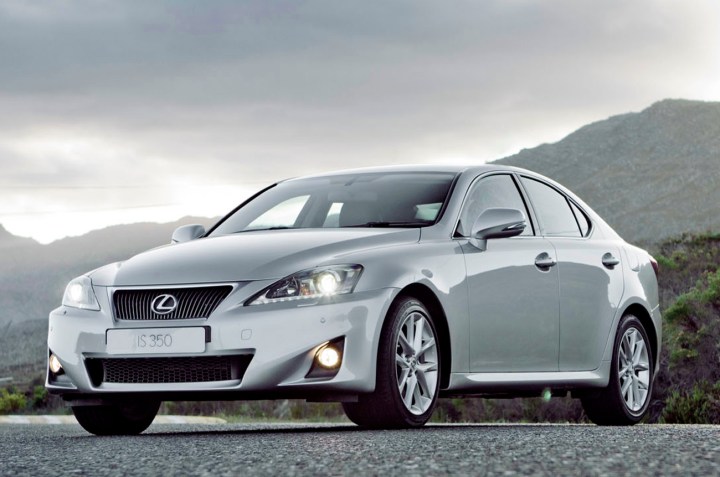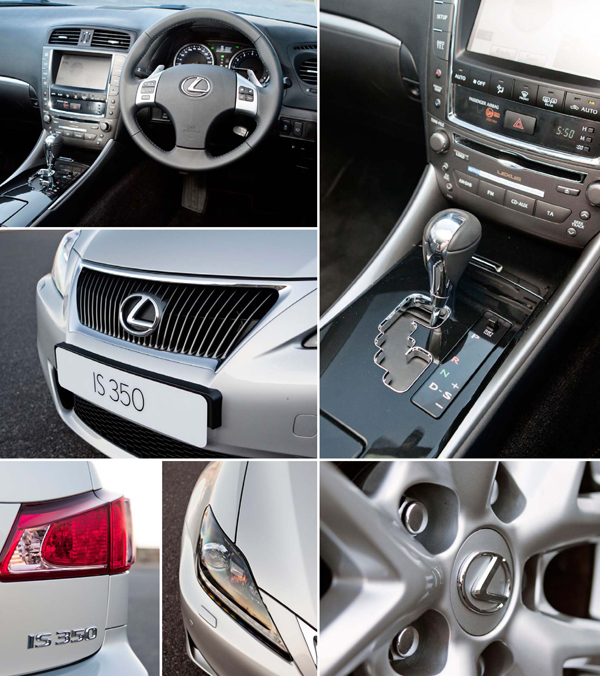Sci-Tech, South Africa
Lexus IS350: Oh so close, but no cigar

The Lexus IS could be considered the brand’s knight in shining armour. It was the advent of the IS – ostensibly a BMW 3-Series/Mercedes-Benz C-class competitor – that brought the nameplate within reach of a wider South African motoring audience, and provided the sales volumes vital to viable dealerships. The new Lexus IS350 is meant to extend the marque’s reach, but DEON SCHOEMAN questions its success in that quest.
The Lexus brand used to struggle in the shadow of parent Toyota, at least at retail level. Created as a separate, luxury brand specifically to provide an alternative to established premium marques, Lexus did brisk business in the US, but battled in other markets.
Part of the reason was a lack of charisma. Targeting the S-class and 7-Series, those first Lexus LS cars were big and beautifully built. But despite offering everything that opened and shut, and achieving class-leading levels of refinement, the LS suffered from blandness.
In the South African context, Lexus faced a further hurdle. Showrooms were typically located directly adjacent to the Toyota retail space, meaning that prospective buyers were continuously reminded of the close relationship with the mass-market brand.
Frankly, nobody spending a considerable amount of dosh on a luxury limo wants to rub shoulders with Corollas and Camrys. But with a severely limited model range, the potential sales volumes were simply too low to warrant a separate Lexus dealer network.
Fast-forward two decades and the Lexus picture has become a lot rosier. Those smart, monochromatic Lexus dealerships dotted around major centres are proof the brand has earned its spurs in the luxury-car market.
Core to the marque’s momentum is an expanded range that now embraces everything from high-tech hatchbacks and hybrid SUVs to top-end luxury limousines. But in volume terms, it’s the IS sedan that has played the biggest role in the brand’s coming of age.
The IS has taken what was a niche, high-end brand into the premium motoring mainstream, offering a real alternative to buyers in a segment dominated by the 3-Series, C-class and A4 brigade. That it happens to be handsome, distinctive and well-equipped has only added to its charm.
Up to now, IS buyers have had little in the way of choice. The IS250 remains the range’s mainstay, linking the car’s distinctively wedged profile to a smooth 2.5-litre V6, an automatic gearbox and a choice of two specification levels, both luxurious.
By comparison, the IS-F is Lexus’ take on hard-core sports sedan motoring – a car designed to add performance spice to the compact sedan recipe in the same way BMW and Mercedes-Benz have done with their M cars and AMG models respectively.

Photo: The most telling difference between the existing IS250 and its IS350 sibling is the powerplant under the bonnet.
With 311kW from a muscular V8 propelling the lithe sedan to 100km/h in less than five seconds, the IS-F is more monster than motor car, and just that little bit too muscular for most IS buyers, while an R808k price tag also excludes it from gaining mass-market sales appeal.
So, two sides of the same IS coin then, but very different sides they are. And until recently, the problem was there wasn’t anything in between from which would-be IS buyers could choose. Which is where the IS350 comes in.
As the badge implies, the most telling difference between the existing IS250 and its IS350 sibling is the powerplant under the bonnet. The newcomer employs a beefier 2GR-FSE V6 engine that extracts a substantial 233kW at 6,400rpm from its 3,456cc capacity. Torque is an equally generous 378Nm, albeit at a peaky 4,800rpm.
If the objective was to create a more muscular, more athletic IS without the uncompromising dynamics (and the equally uncompromising price tag) of the IS-F, then Lexus has succeeded. This is a very rapid machine, by any standards.
Lexus claims a zero-to-100km/h sprint time of 5.6sec, and a top speed electronically restricted to 230km/h – and on the move, those figures appear to be entirely plausible. Responses are rapid and unequivocal and the throttle feels almost too sharp, especially in stop-start city traffic.
Drive remains to the rear wheels (doffing the hat yet again to its Teutonic competition). But it’s the gearbox that is out of kilter with the rest of the package – or rather, the way it operates. There’s nothing inherently wrong with the six-speed auto gearbox. It’s a conventional torque converter design and lacks the almost percussive shift action of modern-day dual-clutch transmissions.
Even that wouldn’t have been such a problem (at this level, the boy racers are few and far between). Instead, it’s the expectations created by the presence of a set of shift paddles behind the chunky steering wheel that hamstring the IS350’s potential.
Now, forgive me for being pedantic here, but surely, shift paddles are provided so that the driver can rapidly decide when to swap to a higher or a lower gear, without interference. Not so, it seems in Lexus land.
Even in Sport mode, the gearbox always acts more automatic than manual. Forget about short-shifting through the gears – the IS350 will only swap cogs when it’s good and ready. And while it will heed instructions to downshift, it will automatically determine the best time to shift up regardless of how the driver operates the paddles.
In fact, so frustrating are the attempts to assume control of the cog-swapping process that it’s best to ignore the shift paddles completely and leave the gearbox to its own devices. In other words, those shifters are worth less than a pair of old socks.
Given that the IS350’s claim to fame includes a sporty personality – and since many torque converter-equipped auto boxes still manage to change gears with incisive alacrity – this latest Lexus IS model deserves better. Besides, it has much to recommend it on other levels.
For one, the styling remains true to the sleek IS ethos, with just a touch of extra aggression to make it stand out from the crowd. Thanks to its wide tracks, low stance and short overhangs, the IS350 looks even more muscular than the standard version – a clear indicator of its performance potential.

Photo: The IS350 looks more muscular than the standard version.
The newcomer is offered in a choice of trim levels: EX, and the top-end SE version tested here. As we’ve come to expect of Lexus, it is fitted with a full house of standard equipment. Execution is luxurious, ensuring high comfort levels, and without resorting to garish aesthetics or exaggerated finished. It’s all nicely restrained and understated.
However, it is obvious that the IS350’s dynamics are meant to take centre stage. With a kerb mass of around 1.6tons, the power-to-weight ratio is a fairly impressive, and the car feels commensurately agile off the mark.
While straight-line dynamics are relatively simple to achieve, ensuring wieldy and communicative road manners in the twisties is a little more difficult to accomplish. The IS350 follows in its less-powerful sibling’s boots in this regard, making the most of its dual front wishbone suspension and multi-link rear configuration to offer confident cornering and good overall stability.
As is so often the case, the steering lacks a certain measure of feedback and often feels just too over-assisted to ensure true driver involvement. But it never gets in the way of being able to pilot the IS350 through curves and corners with confidence.
Quality has become synonymous with the Lexus nameplate, and the test car did nothing to cast any doubt on that hard-earned reputation. And, in line with contemporary automotive design, safety is well catered for in both active and passive terms.
That includes a decent set of brakes to tame the IS350’s considerable speed potential when required. The front and rear discs are easily modulated and provide tenacious stopping power, with ABS assistance readily on offer when needed.
I felt a little let down by the new IS350. It’s a car that, on paper at least, should be more junior IS-F than big-brother IS250. It shows all the promise of a truly great sports sedan, and ticks all the vital boxes except one: the gearbox.
Perhaps the typical IS350 buyer won’t want to play with the shift paddles. Perhaps the Lexus motoring audience places ease of use and comfort over exploring the athletic capabilities of a car such as this.
But then, Lexus has missed a golden opportunity to extend the IS range’s appeal to motorists with the cash and the enthusiasm to enjoy what the IS350 should – and mostly is – capable of. When the overall package is this promising, it’s truly a pity to have to forego that cigar. DM
Vital statistics: Lexus IS350 SE
- Engine: 3,456cc V6, DOHC/bank
- Gearbox: Six-speed automatic
- Power: 233kW @ 6,400rpm
- Torque: 378Nm @ 4,800 rpm
- 0-100 km/h: 5.6sec
- Top speed: 230km/h
- Fuel consumption: 9.8-litres/100km
- CO2 emissions: 223g/km
- Retail price: R548 600
Photo: Lexus IS350 – the overall package is promising, but there’s no cigar.




 Become an Insider
Become an Insider